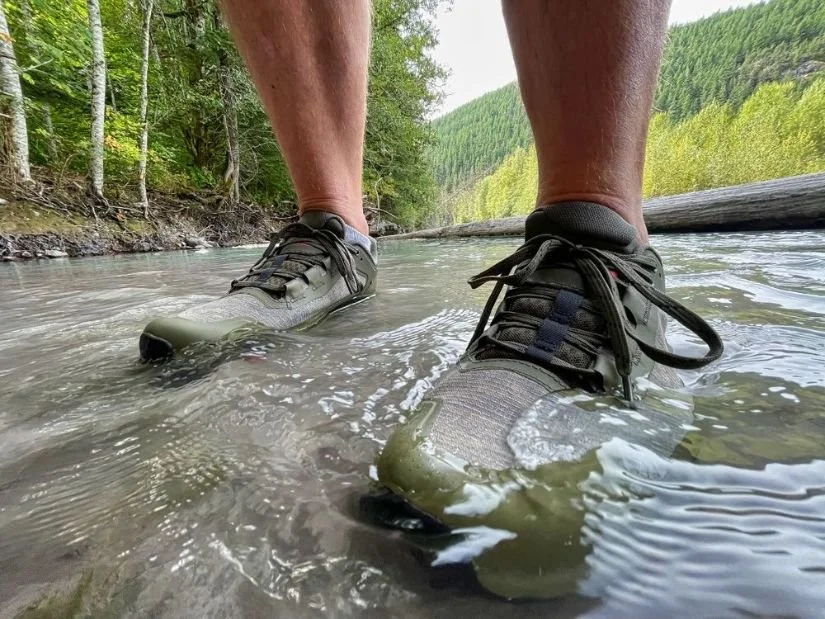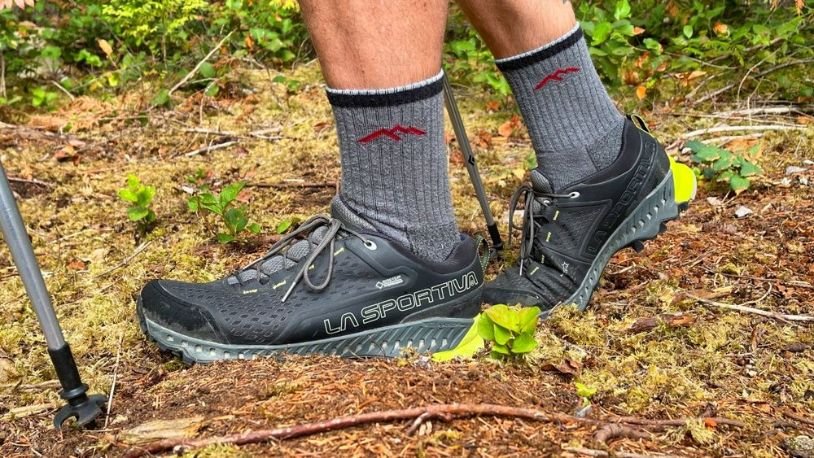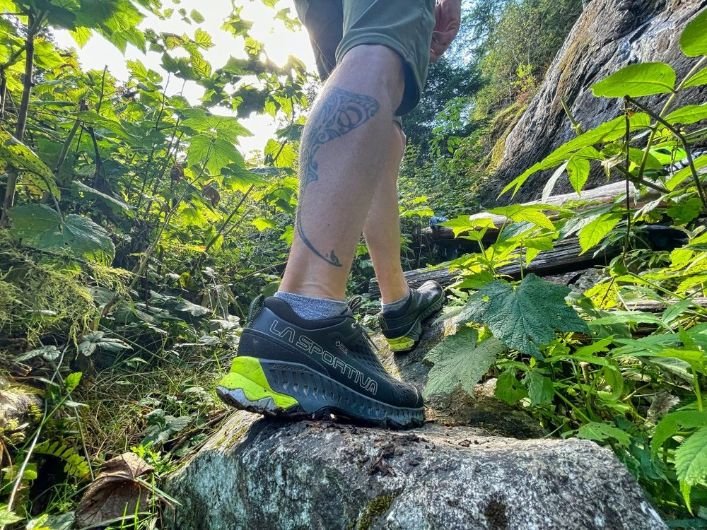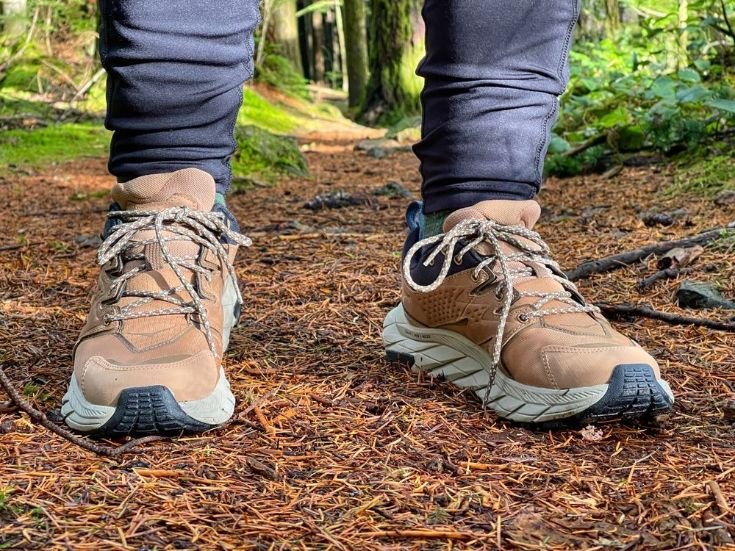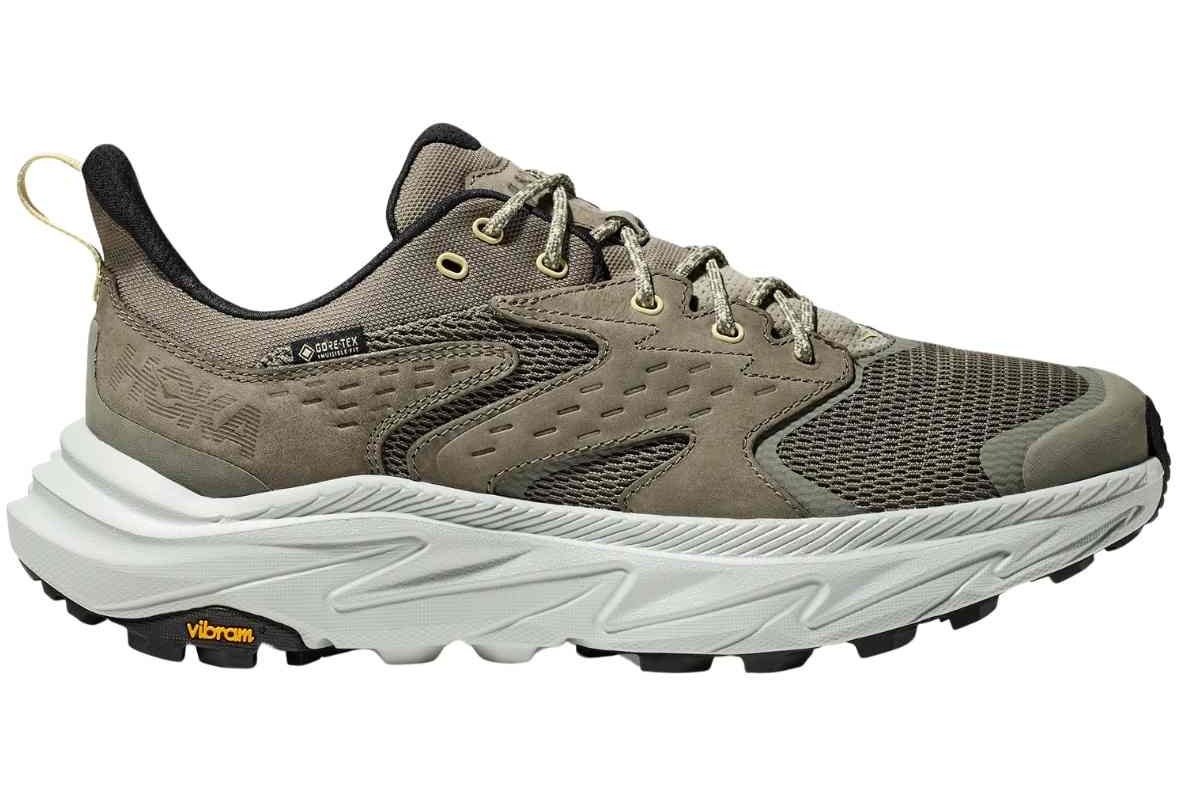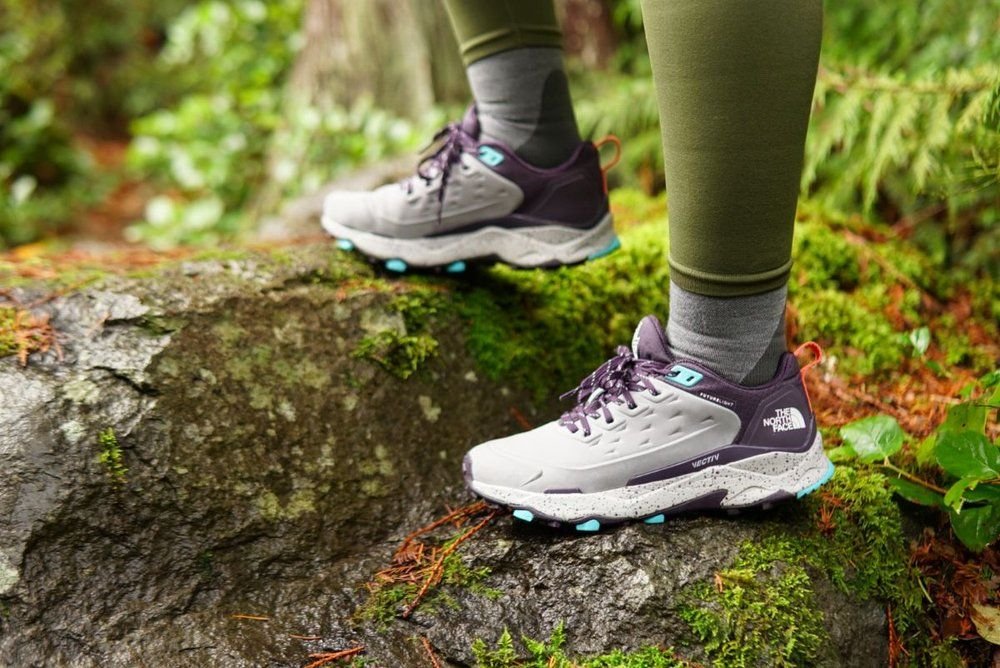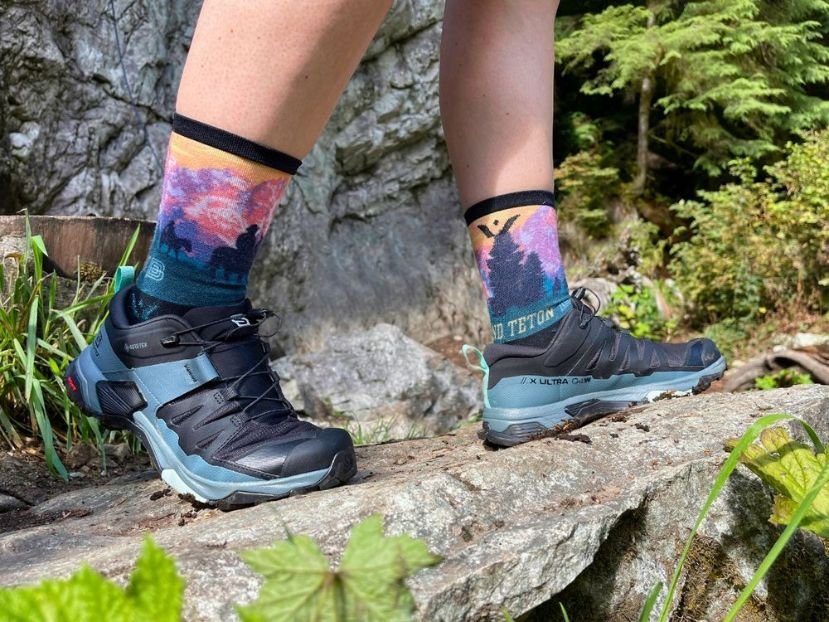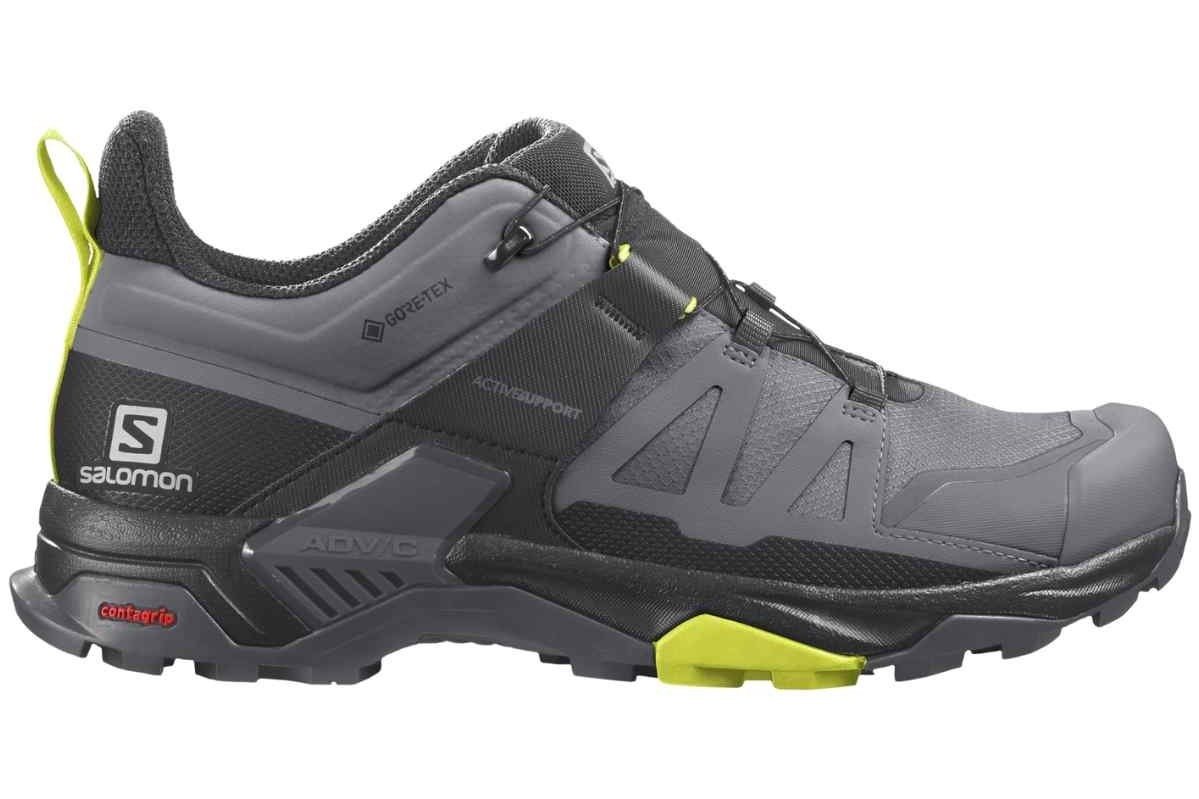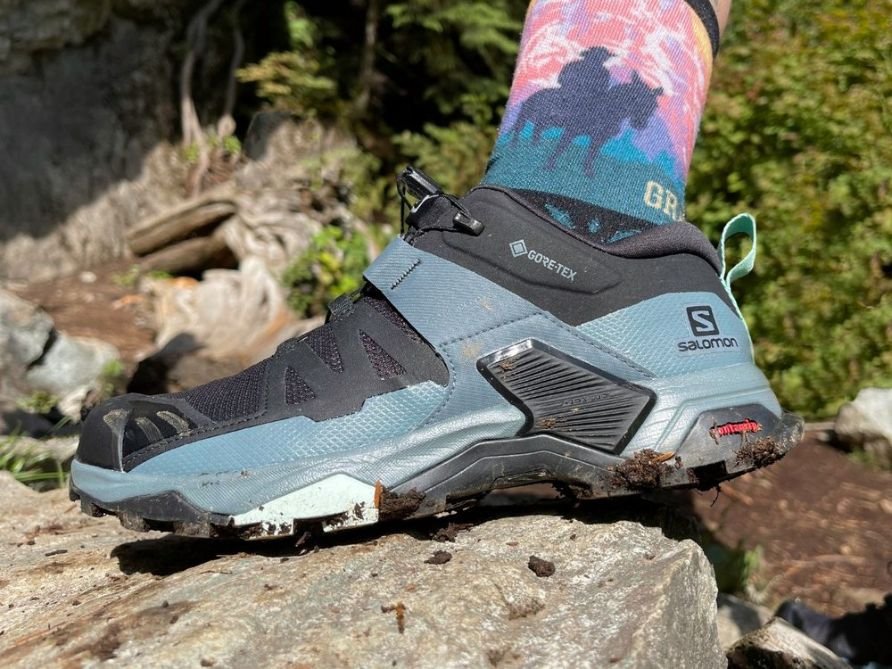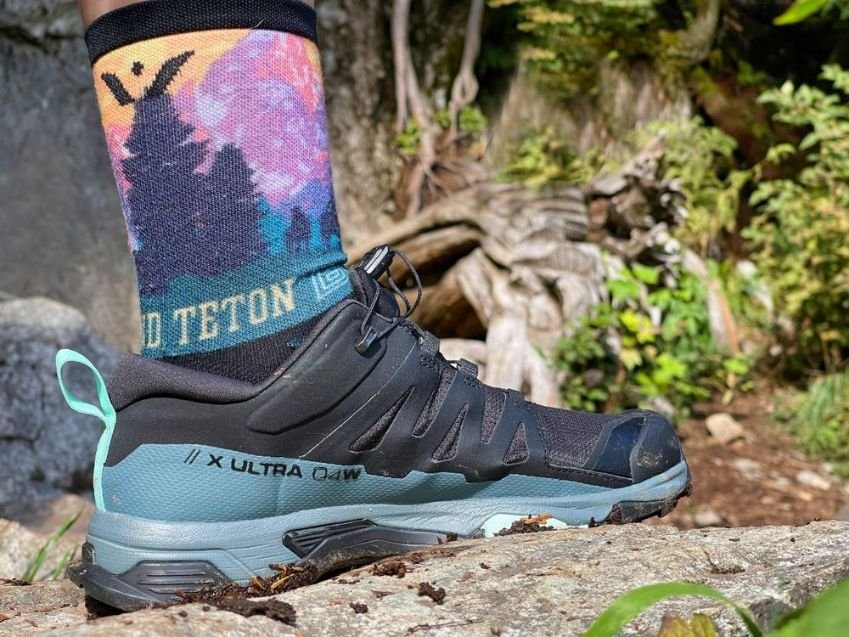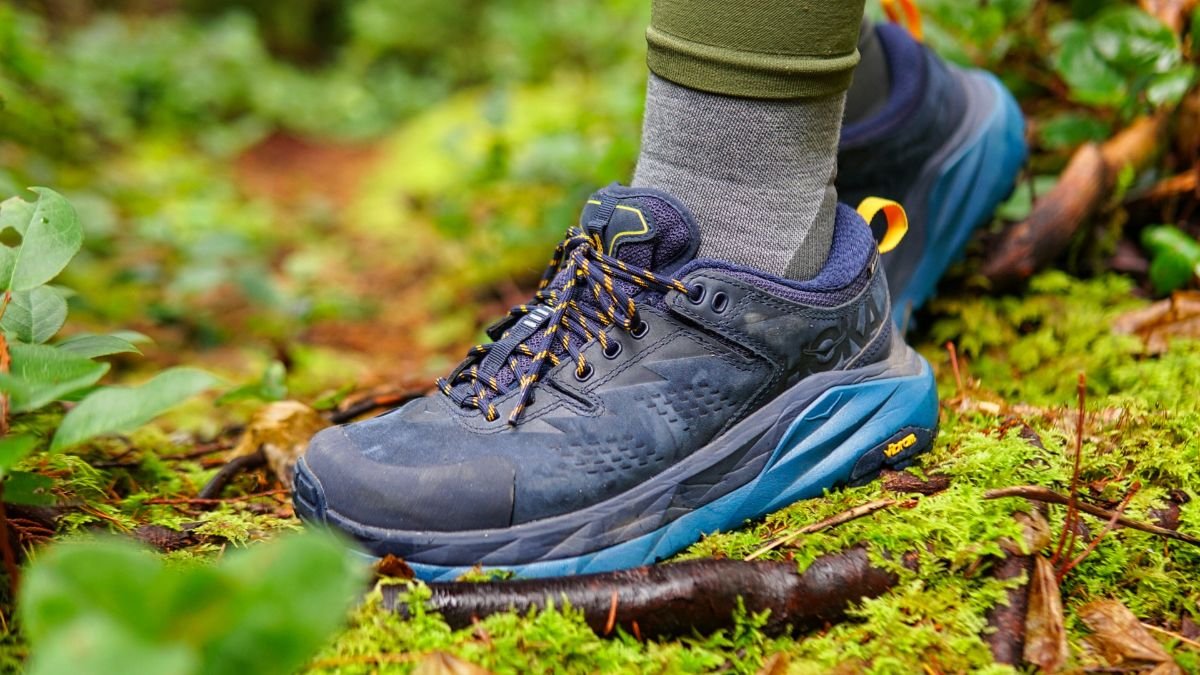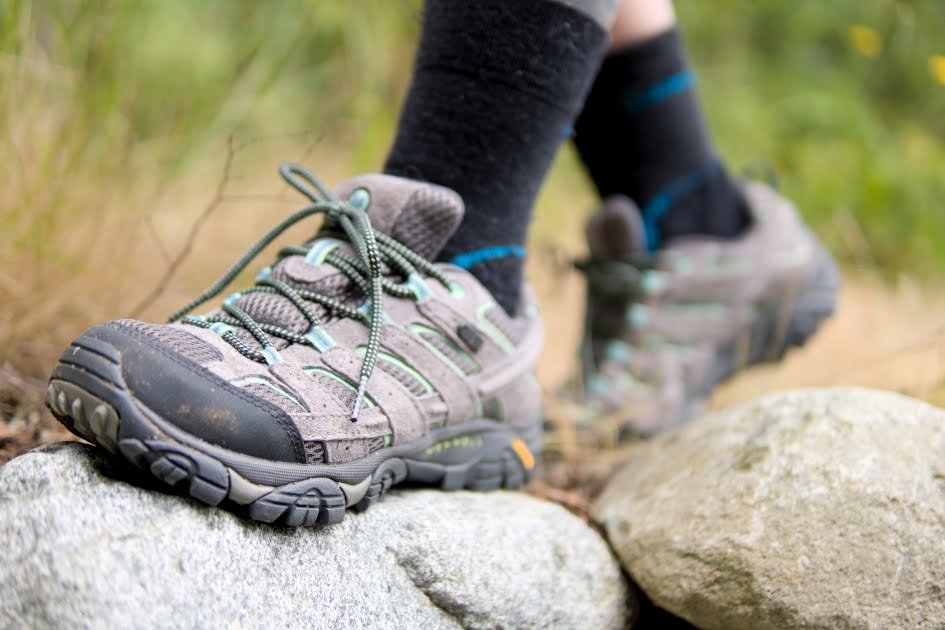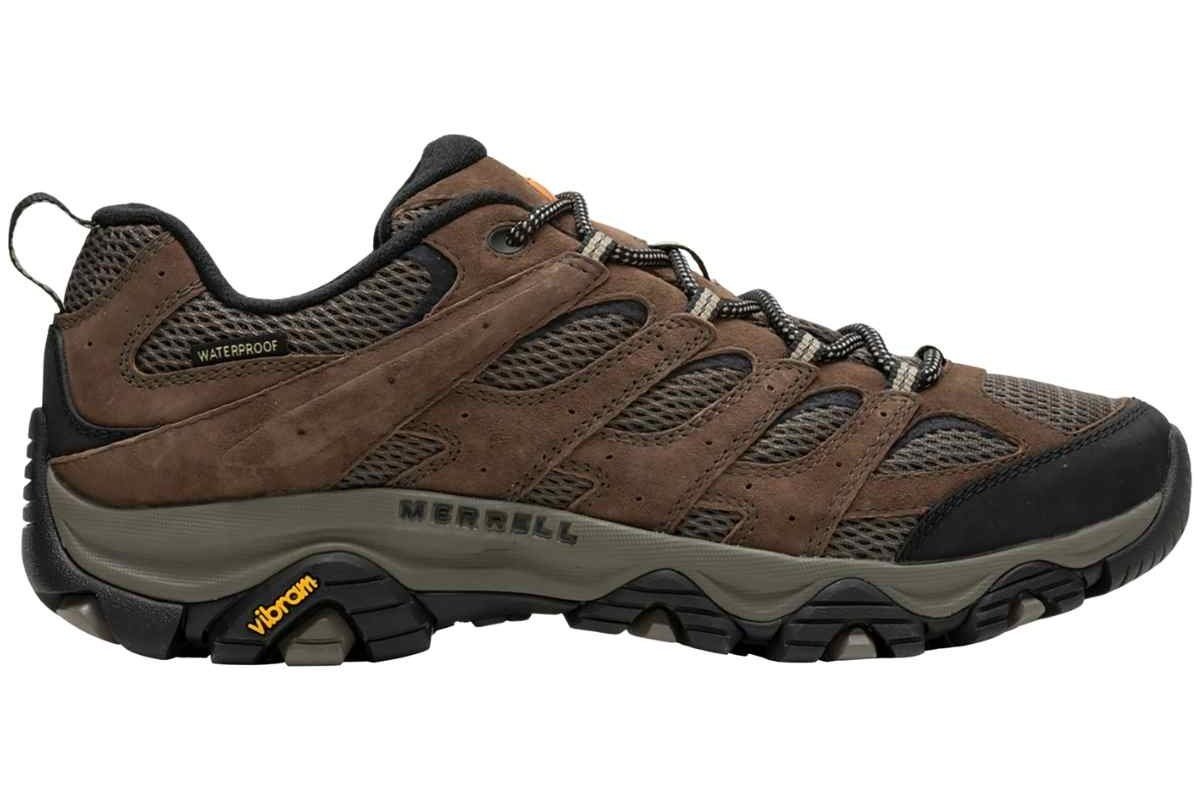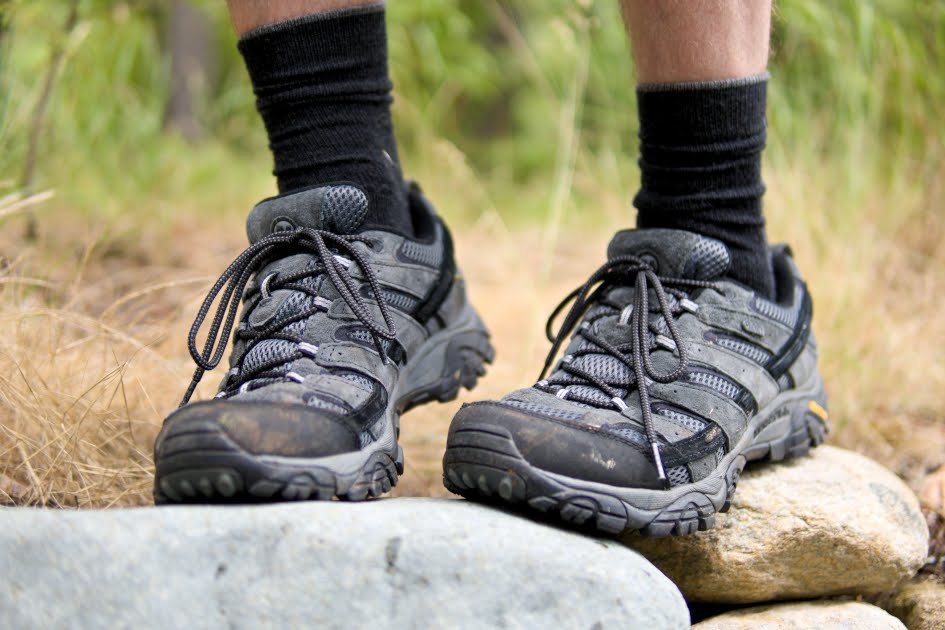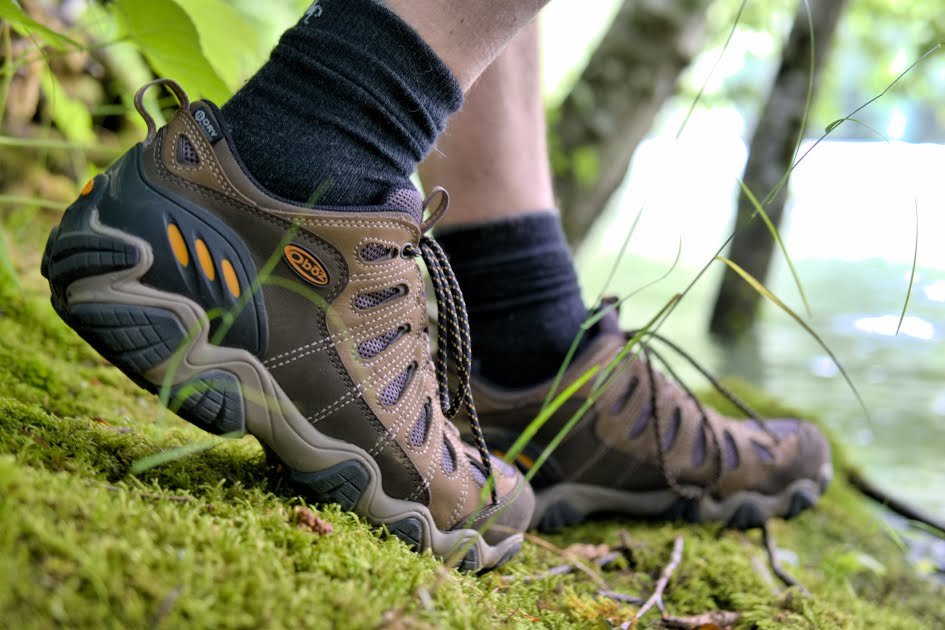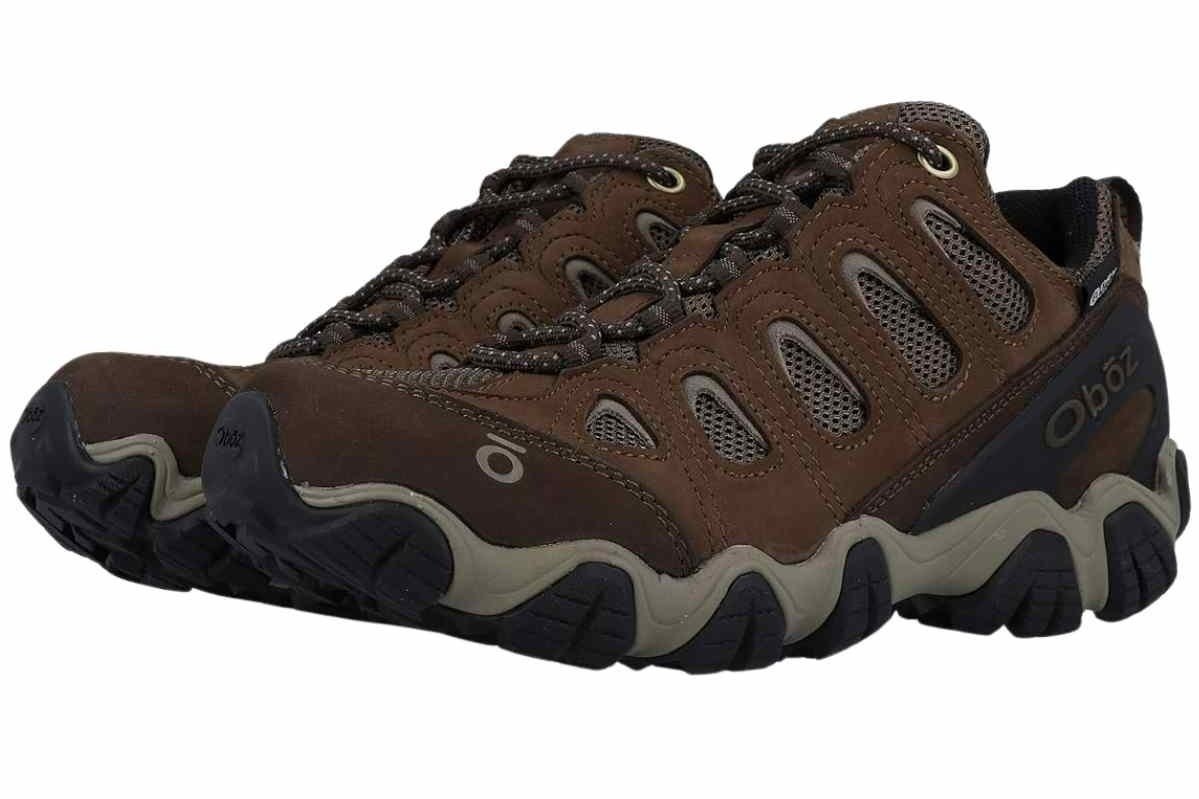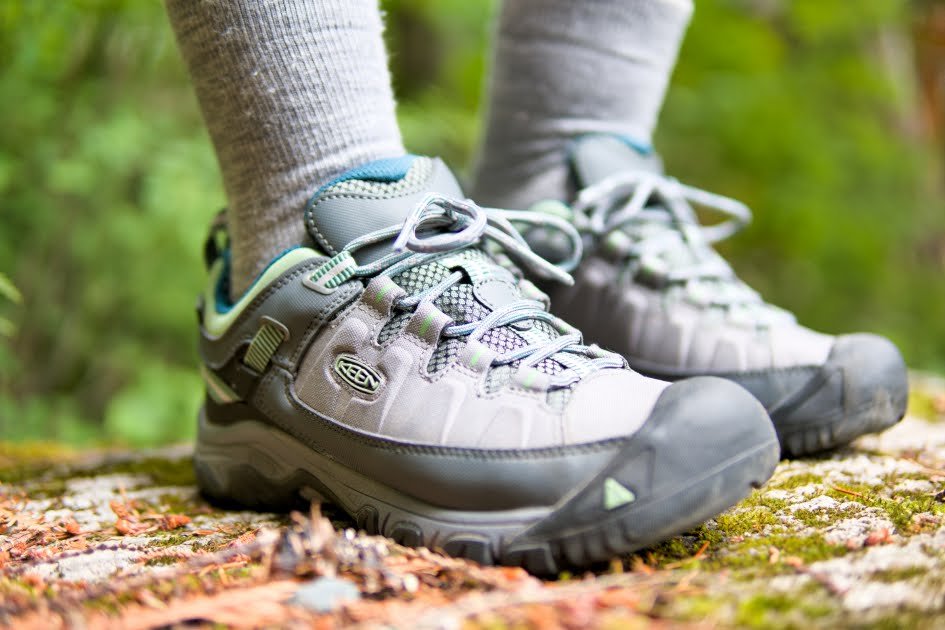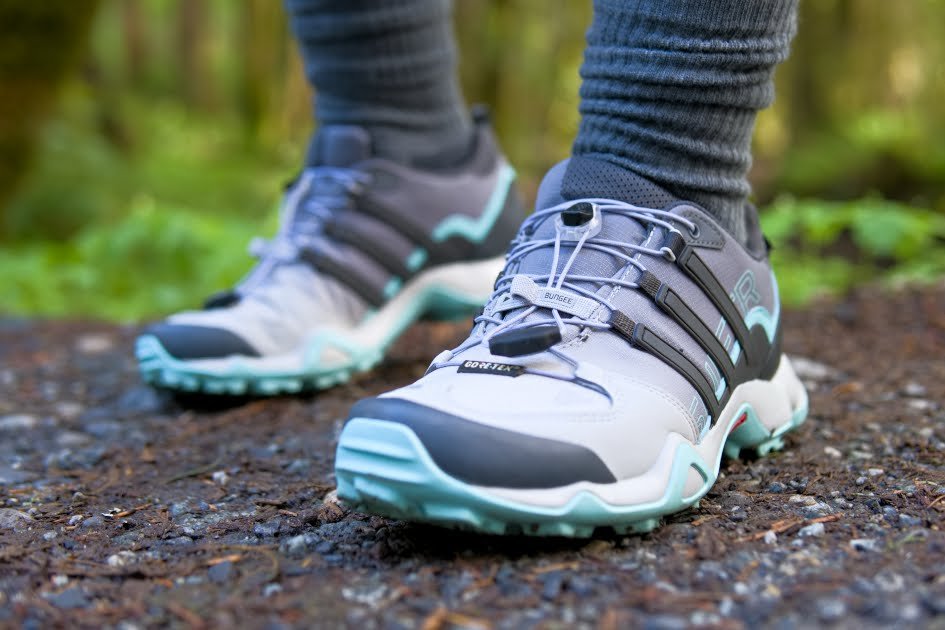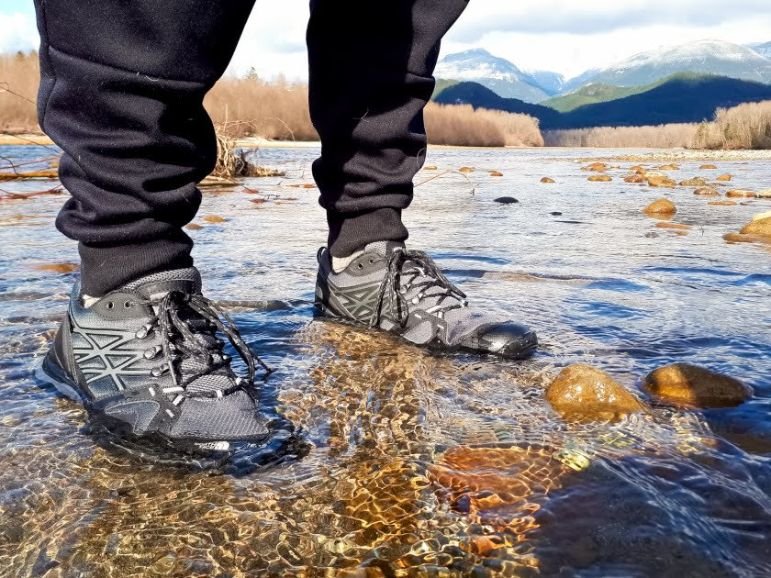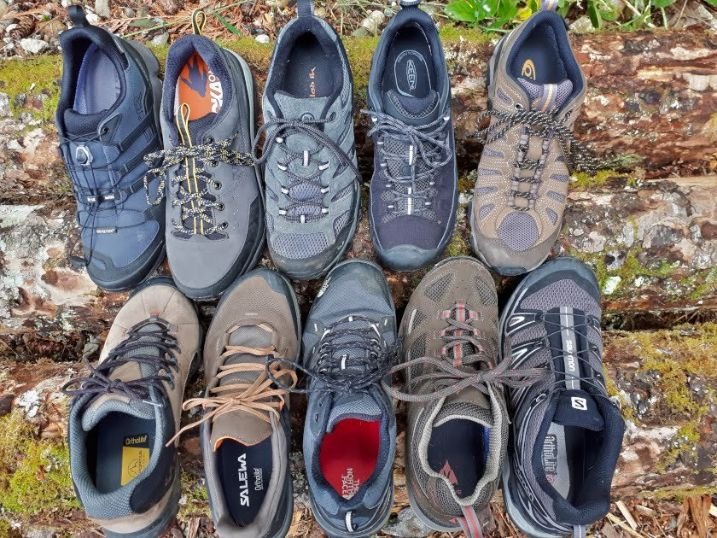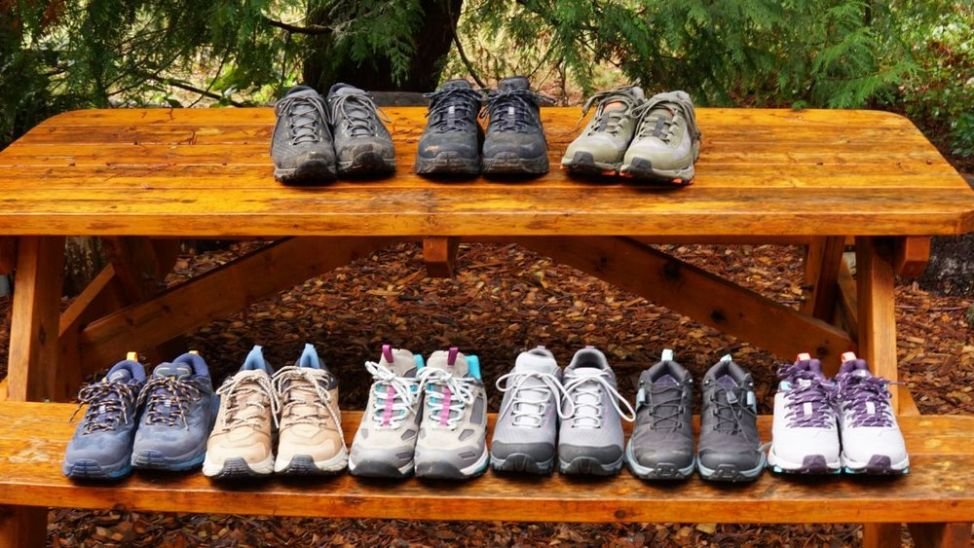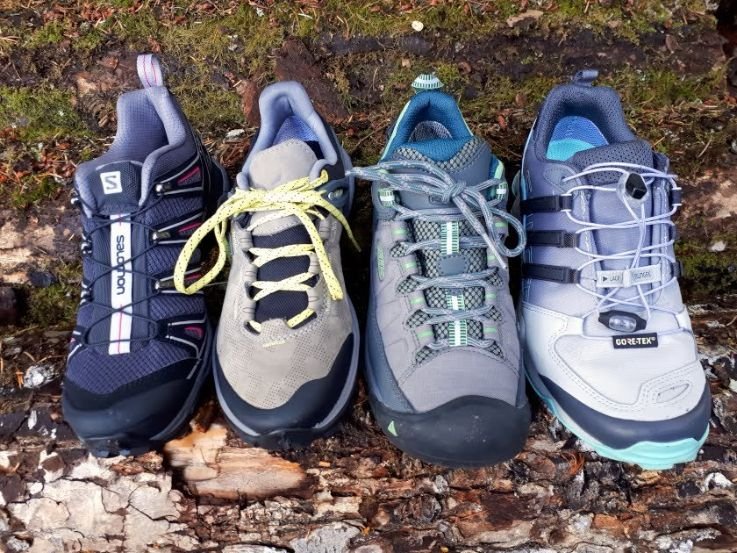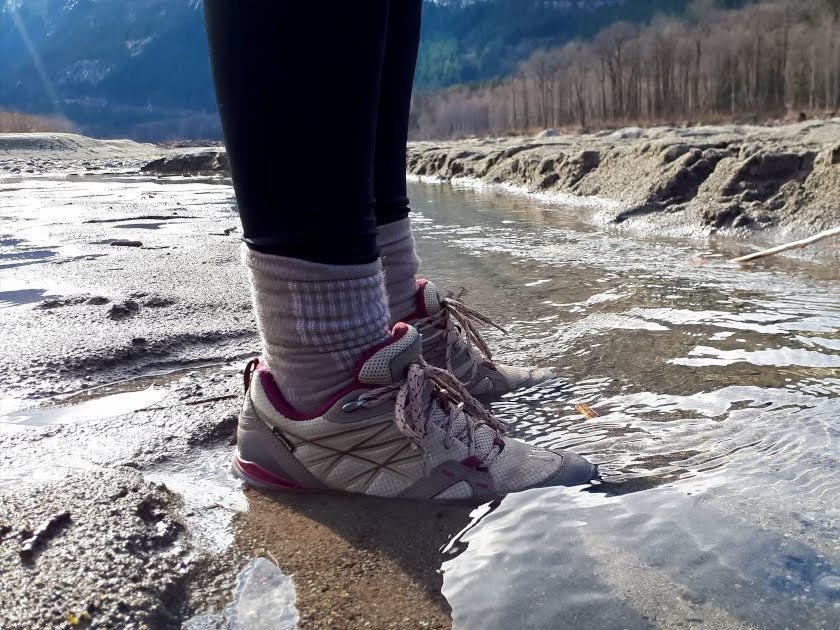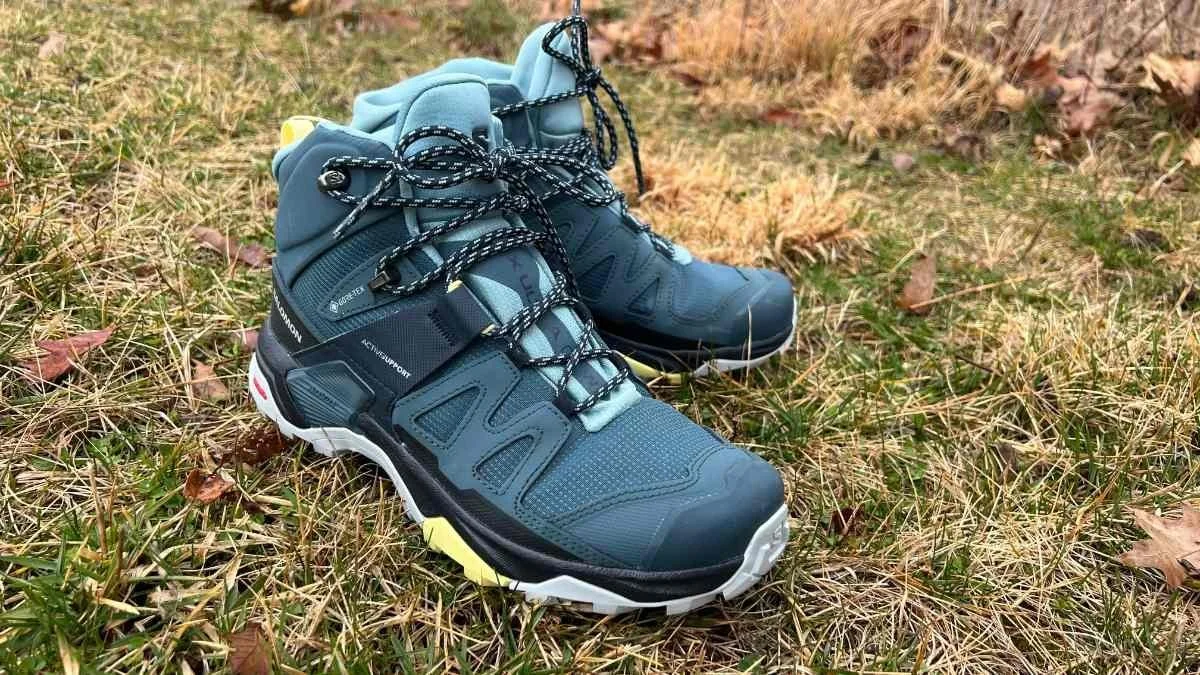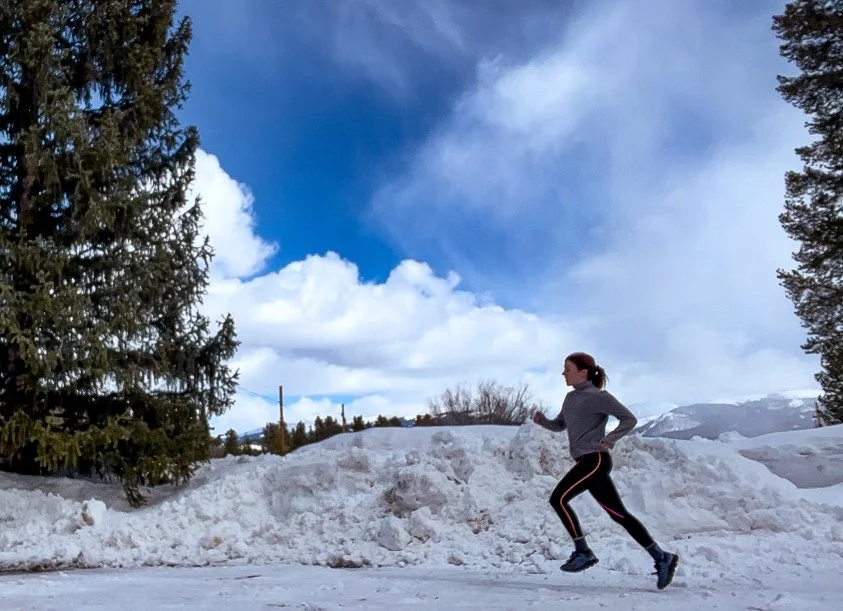Best Hiking Shoes of 2024
The Best Comfortable, Supportive, and Waterproof Lightweight Hiking Shoes
We’ve tested more than two dozen of the most popular pairs of hiking shoes for stability, support, waterproofness, and durability. Photo by Ebony Roberts.
Home > Gear Reviews > Footwear
February 22nd, 2024
Over the past five years, we’ve looked at countless hiking shoes, choosing more than two dozen of the best models to trail-test and review. To update our winners for the best hiking shoes of 2024, we removed discontinued items, replaced some past winners with newly-tested hiking shoes, and kept some classics that are still worth considering. We chose waterproof hiking shoes suitable for day hiking and light backpacking-everything from a few miles of urban hiking to a few days in the backcountry.
Our best hiking shoes list consists of two winners, two runner-up winners, and ten other top contenders. While our two top winners prioritize different features and attributes, they’re equally capable of most hiking pursuits. Above all, they’ve got what matters most: comfortable fit, stable foothold, durable construction, and the ability to keep your feet dry.
Whether you’re looking for agile and fast-moving footwear — or rugged hikers for steep terrain and rocky ascents — here are 14 of the best hiking shoes and lightweight hiking shoes currently on the market.
This story may contain affiliate links, which help fund our website. When you click on the links to purchase gear, we may get a commission. This allows us to create reader-supported, objective gear reviews, independently selected by our editors — without costing you an extra cent. Thank you for supporting our work and mission of outdoor coverage for every body! Learn more.
Comparison Table
Men’s
| HIKING SHOE | BEST FOR | WEIGHT PER PAIR | WATER PROOFING | UPPER MATERIAL | MIDSOLE | OUTSOLE | MSRP* |
|---|---|---|---|---|---|---|---|
| La Sportiva Spire Low GTX | Light backpacking and technical terrain Read review |
1 lb 8.2 oz | GORE-TEX Surround | Mesh, polyurethane Techlite toe and heel | Vibram XS Trek rubber | Vibram XS Trek outsole | $209 |
| Hoka Anacapa Low GTX | Most comfortable hiking shoes Read review |
1 lb 8.8 oz | GORE-TEX Invisible Fit | Nubuck leather, recycled mesh | Compression-molded EVA (30% sugarcane) | Vibram Megagrip rubber | $180 |
| The North Face Vectiv Exploris 2 Futurelight | All-around for urban and day hiking Read review |
1 lb 7.2 oz | 3-layer FutureLight | Leather | Rocker geometry midsole | Surface Control rubber | $179 |
| Salomon X Ultra 4 | Traction, support, and comfort Read review |
1 lb. 9.6 oz | GORE-TEX | Synthetic/ textile | EnergyCell | Rubber | $160 |
| Hoka Kaha 2 Low GTX | Comfort, high cushion Read review |
1 lb. 11.6 oz. | GORE-TEX | Nubuck leather, recycled mesh and polyester | 2-density CMEVA (rubberized EVA) | Vibram Megagrip rubber | $220 |
| Merrell Moab 3 WP | Affordable hiking shoe Read review |
1 lb. 10 oz | Waterproof breathable membrane | Suede leather, mesh | EVA | Vibram TC5+ | $120 |
| Oboz Sawtooth II Low Waterproof | Backpacking and light loads Read review |
1 lb. 11.6 oz | B-DRY | Nubuck leather | Dual-density EVA | Sawtooth | $140 |
| Keen Targhee IV Low WP | Wide feet Read review |
1 lb. 9.2 oz | KEEN.Dry | Oiled nubuck leather | Dual-density EVA | Rubber | $165 |
| Adidas Terrex Swift R3 GTX | Fast and light Read review |
1 lb. 8 oz | GORE-TEX Performance Comfort | Warp-knit textile | Lightstrike EVA | Continental Rubber outsole | $160 |
| The North Face Hedgehog Fastpack II WP Low | Nimble Read review |
1 lb 8 oz | DryVent | Polyurethance-coated leather, synthetic nubuck | Single-density EVA | Vibram Trek | $129 |
Women’s
| HIKING SHOE | BEST FOR | WEIGHT PER PAIR | WATER PROOFING | UPPER MATERIAL | MIDSOLE | OUTSOLE | MSRP* |
|---|---|---|---|---|---|---|---|
| La Sportiva Spire Low GTX | Light backpacking and technical terrain Read review |
1 lb 8.2 oz | GORE-TEX Surround | Mesh, polyurethane Techlite toe and heel | Vibram XS Trek rubber | Vibram XS Trek outsole | $209 |
| Hoka Anacapa Low GTX | Most comfortable hiking shoes Read review |
1 lb 8.8 oz | GORE-TEX Invisible Fit | Nubuck leather, recycled mesh | Compression-molded EVA (30% sugarcane) | Vibram Megagrip rubber | $180 |
| The North Face Vectiv Exploris 2 Futurelight | All-around for urban and day hiking Read review |
1 lb 4.6 oz | 3-layer FutureLight | CORDURA ripstop mesh | Rocker geometry midsole | Surface Control rubber | $179 |
| Salomon X Ultra 4 | Traction, support, and comfort Read review |
1 lb. 9.6 oz | GORE-TEX | Synthetic/ textile | EnergyCell | Rubber | $160 |
| Hoka Kaha 2 Low GTX | Comfort, high cushion Read review |
1 lb. 11.6 oz. | GORE-TEX | Nubuck leather, recycled mesh and polyester | 2-density CMEVA (rubberized EVA) | Vibram Megagrip rubber | $220 |
* See our Deals Page for discounts and sales on products that win our awards.
See our most popular hiking articles or see all our Hiking Gear Guides:
The Best Men’s and Women’s Hiking Shoes
We’ve hiked with the Spire in peak-summer temperatures and the rainy Pacific Northwest (PNW), and the mix of breathability and waterproofness is some of the best we’ve experienced. Photo by Ebony Roberts.
La Sportiva Spire Low GTX: The best hiking shoes for light backpacking and technical terrain
Weight (men’s): 1 lb 12.8 oz (per pair)
Weight (women’s): 1 lb 8.2 oz (per pair)
Upper Material: Mesh/polyurethane Techlite toe and heel
Waterproofing: GORE-TEX SURROUND waterproof breathable membrane/textile
Midsole Material: Vibram XS Trek rubber
Outsole: Vibram XS Trek
What we liked: versatility, stability, support, can handle most terrain and conditions, technical and breathable, height of collar keeps water our during creek crossings
What we didn’t like: not available in wide sizing, a little pricier than some other options
The La Sportiva Spire GTX is our winner for best hiking shoe because of their all-around performance that blends lightweight movement with stability and support. If we had to pick one shoe to take us through most situations comfortably and safely, this is the one.
The Spire GTX combines the nimbleness of wearing trail runners with the support and protection of a lightweight hiking boot. (La Sportiva even classifies the Spire as a low-cut hiking boot). This shoe stood out for its versatility and comfort; it’s got hard outsoles that can handle long days on rocky, technical terrain and breathable synthetic uppers that are great for hiking in the heat. The Spire quickly became our go-to shoe for dog walks in the muck and our first choice for hiking with a loaded backpacking backpack or child carrier.
Men's
Women's
The La Sportiva Spire GTX is our winner for best hiking shoe because of their all-around performance that blends lightweight movement with stability and support. Photo by Ebony Roberts.
Breathability and ventilation
We’ve hiked with the Spire in peak-summer temperatures and the rainy Pacific Northwest (PNW), and the mix of breathability and waterproofness is some of the best we’ve experienced (note: non-waterproof trail shoes will always be more breathable than waterproof trail shoes).
Made entirely of synthetic materials, the overall system allows water vapor on the inside to escape even through the footbed and midsole, thus keeping feet sweat-free; the Gore-Tex Surround membrane keeps feet moisture from entering the shoe.
Design and height
We like that the shoe sits a little taller on the leg than other models because it makes more creek crossings possible without water breaching the top of the shoe. The height of the collar also prevents ankle rolls, and the padding around the heel keeps the shoe from rubbing (a common cause of blisters).
The extended gusseted tongue keeps water debris out, and the lacing system stays snug.
The lugs on the stiff Vibram XS Trek soles are some of the most aggressive we looked at for this review-chomping down on the terrain, leaving little room for slippage, and offering protection from sharp rocks and obstacles underfoot. Photo by Steve Redmond.
Traction and cushioning
The lugs on the stiff Vibram XS Trek soles are some of the most aggressive we looked at for this review-chomping down on the terrain, leaving little room for slippage, and offering protection from sharp rocks and obstacles underfoot.
Supportive cushioning combined with TPU (a type of plastic often utilized in hiking footwear due to its strength, high elasticity, and shock absorbency) inserts in the midsole adds stability, and the prominent heel brake makes for more controlled movements on tricky descents.
Durability
The abrasion-resistant mesh upper has held up well through years of testing, but the fabric and thin-film combo was more susceptible to nicks and tears than a shoe with thicker material. However, reinforcement is placed in critical areas to add protection and durability to the shoe. One of the standout details is the hard material on the heel and toe box, which shields the feet and guards the shoe against trail abrasion.
Size and fit
Although wide sizing and shoes for narrow feet are not available, the Spire has an average fit and should work for most foot shapes. It’s worth mentioning that many customer reviews across popular retailers note that the Spire fits well for narrow-footed individuals, but wide-footed people might do better looking elsewhere.
Our verdict
Although the Spire is among the most expensive (at just under two hundred dollars), we can’t deny their outstanding performance. We think the Spire is a worthy investment if you’re looking to move out of a hiking boot but still want support, protection, and stability.
Curious about outdoor footwear? See our most popular articles on footwear:
The Hoka One One Anacapa Low GTX have everything that people have come to love about Hokas-- cushion, propulsion, and support. Photo by Ebony Roberts.
Hoka Anacapa 2 Low GTX: most comfortable hiking shoes
Weight (men’s): 1 lb 14.7 oz
Weight (women’s): 1 lb 8.8 oz
Upper Material: Waterproof Nubuck leather/recycled mesh
Waterproofing: GORE-TEX Invisible Fit waterproof/breathable laminate
Midsole Material: Compression-molded EVA (30% sugarcane)
Outsole: Vibram Megagrip rubber
What we liked: comfort, cushioning, propulsion, support, lightweight, combats foot fatigue, heel geometry helps with heel-to-toe transition, feels like you can hike farther, sustainability (PFC-free), also available in kids’ sizing
What we didn’t like: price, extra bulk takes getting used to
The Hoka Anacapa Low 2 are the best marriage of a hiking boot and trail running shoe to date. With everything that people have come to love from the brand-- cushion, propulsion, and support--there’s an added boost of rigidity and a couple of thoughtful design features that make these hiking shoes stand out. As one of our top winners, we think it’s a solid choice for almost any trail terrain or as a walking shoe, letting you hike or urban explore for hours without compromising comfort.
Hoka footwear is synonymous with lightweight comfort, and the Anacapa Low 2 stays true to form. The rockered sole combats foot fatigue, provides all-day support, and the extended heel geometry helps with heel-to-toe transition (though it adds extra bulk and can take some getting used to).
Once you’re familiar with the rockered shape and extended heel, you’ll feel like you can hike longer with less effort. And, at the end of a long day, the shock-absorbing soles mean you won’t be rushing to get your shoes off.
Men's
Men's
Women's
Women's
The Hoka Anacapa’s Vibram sole is sticky, yet they still have the comfy, stable ride that Hoka’s known for, with some extra rigidity that added to our on-trail confidence. Photo by Ebony Roberts.
Traction and grip
The Anacapa’s Vibram Megagrip soles are sticky! When we wore them around the house, they made a suction cup-like sound as they held onto the hardwood; and when tackling slick, moss-covered rocks outdoors, they kept us upright.
Midsole and cushioning
The new EVA midsole (made of 30% sugarcane) is more firm than the original Hoka Kaha hiking shoes we tested, so there’s a little less bounce than in the previous model. But, they still have the comfy, stable ride that Hoka’s known for, with some extra rigidity that added to our on-trail confidence. The shoe’s base was noticeably more narrow than the original Kaha’s, too, which we think makes it more agile.
Features and fit
The pull tab is one of our favorite features on the Anacapa Low 2. It makes slipping in your foot incredibly easy, and it hugs the Achilles, which decreases heel slippage and increases support. Not only does the cushy pull-tab add to the straight-out-of-the-box comfort, we feel like it makes the shoe more responsive to individual movements, twisting with you as you step.
The lacing system is also spot-on with an added eyelet that sits further back on the shoe than we’re used to seeing; this offers you the ability to try different lacing techniques and dial in the fit for your foot.
Waterproofing and breathability
The new Gore-Tex Invisible Fit breathable waterproofing system on the Anacapa 2 held up to our Pacific Northwest weather. Our feet remained dry while crossing water and hiking in the rain due to Gore-Tex Invisible Fit and a PFC-free weather-resisting treatment.
Gore-Tex Invisible Fit gives complete protection with a more flexible fit and feel than other Gore-Tex membranes by being bonded directly to the recycled mesh upper, eliminating folds that can become pressure points and reducing weight.
Durability
This shoe has been out for almost a year and we still have no durability issues to report. The waterproof Nubuck leather and recycled mesh upper has held up well to abrasion. Leather covers the areas that take most of the brunt, like along the sides and around the back, and a rubber toe cap adds a thin layer of protection. The gusseted tongue does its job of keeping water and debris out, and the padding is comfy without being overly bulky.
Sustainability
Those looking for sustainability attributes will appreciate that the lightweight leather is Leather Working Group-certified, the polyester is recycled material, the EVA is 30% sugarcane, and the sock liner is fifty percent soy-based.
Best uses
We think Hoka’s lightweight shoe is a top option for almost any hiking endeavor-from urban hiking on hard pavement, hot summer days in the backcountry, packing a heavy load, and slogging up switchbacks.
Sizing
The Anacapa Low 2 is available in women’s sizes 6 to 11 and men’s sizes 8 to 13. It’s also one of the only models that is available in kids’ sizing.
Our verdict
We also think the Anacapa 2 can double as a trail runner and make a great travel companion for day hiking(these are definitely coming along on our next trip). For a do-it-all lightweight hiking shoe that can handle a week of backpacking without being overkill for a leisurely day hike, the Anacapa 2 checks off all the boxes for a good hiking shoe.
The Vectiv Exploris shoes feature Ghillie lacing-a criss-cross lacing system that stay tightly cinched while you hike. Photo by Steve Redmond.
The North Face Vectiv II Exploris Futurelight: Great All-Around Hiking Shoes for Urban and Day Hiking
Weight (men’s): 1 lb 8.3 oz
Weight (women’s): 1 lb 4.6 oz
Upper Material: CORDURA ripstop mesh
Waterproofing: 3-layer FUTURELIGHT waterproof, breathable membrane
Midsole Material: Rocker geometry midsole
Outsole: Surface control rubber
What we liked: street style vibe makes it a good choice for a mix of city and outdoor adventures, rockered sole provides extra boost, built for variety of trail conditions, lacing system
What we didn’t like: shoes run tight, not as durable as other options
The The North Face Vectiv 2 Exploris Futurelights are responsive, lightweight hiking shoes with a rockered sole that provides an extra boost forward on the trail and saves your legs on long days. While we think the Hoka One One Anacapa is a better choice for most people looking for a rocker, we recommend the Vectivs for anyone who might be put off of the Hokas but who still want propulsion and precision.
Men's
Women's
The North Face Vectiv Exploris Futurelights are responsive, lightweight hiking shoes with a rockered sole that provides an extra boost forward on the trail and saves your legs on long days. Photo by Steve Redmond.
Lacing system and gusseted tongue
The Vectiv Exploris shoes feature Ghillie lacing-a criss-cross lacing system that sees the lace weave through the material of the shoe rather than through single punched holes. Combined with flat laces, the result is that they stay tightly cinched while you hike. Another benefit of this lacing system is that it tightens and loosens different sections across the foot to dial in the fit.
The gusseted tongue also helps prevent water and debris from sliding down into the shoes through the lace holes, and it’s slightly padded, adding to snugness and comfortability.
We tested both the leather and synthetic version of The North Face Vecitiv Exploris. The leather kept our feet warm and dry on chilly days. The synthetic is more breathable. Photo by Steve Redmond.
Materials
We tested both the leather and synthetic versions of the Vectiv Exploris. While the synthetic seemed more breathable, what we liked most about the leather version was the extra bit of protection it provides. It’s also easy to clean (the synthetic model is easy to wipe down).
Waterproofing
For fall hiking in the PNW, the leather version kept our feet warm and dry on chillier days, and after hiking in mud, the leather still looks nearly new. Both models passed the waterproof test on short creek crossings. We stood, shoes submerged almost to the collar, and no water made its way inside.
We were impressed by the waterproofness of The North Face Vectic Exploris hiking shoes. We stood, shoes submerged almost to the collar, and no water made its way inside. Photo by Steve Redmond.
Grip and traction
The Vectiv Exploris is plenty grippy; while wearing them around the city, hiking in the rain, on loose rock, and carrying a toddler, they did not slip under our feet and always felt supportive.
Style
While not for everyone, we like the street-style vibe. If you’re going on vacation and doing a mix of city exploring and outdoor adventuring, we think these are the only shoes you’ll need to pack.
Fit
Multiple customers commented that they thought these shoes run a little tight, and we agree. We did not find them to run too small, but they did feel snugger overall than other shoes of the same size, so keep that in mind if you’re between sizes. It’s also worth noting that the Vectiv is showing more noticeable wear than the other shoes we wore under the same conditions; this is not too significant for now, but we’re keeping an eye on it long-term.
The Salomon X Ultra 4 hiking shoes have excellent traction, comfort, support, protection, and on-trail performance. Photo by Steve Redmond.
Salomon X Ultra 4 GTX: Hiking shoes with great traction, support, and comfort
Weight (men’s): 1 lb. 11.2 oz
Weight (women’s): 1 lb. 9.6 oz
Upper Material: Synthetic/ textile
Waterproofing: GORE-TEX
Midsole Material: EnergyCell
Outsole: Rubber
What we liked: excellent traction, comfort, support, protection, performance, more stylish than previous model
What we didn’t like: durability, not as beloved as its predecessor, the X Ultra 3
The Salomon X Ultra series has been a long-standing favorite among hikers. The newest iteration, the X Ultra 4s is the closest rival to the La Sportiva Spire hiking shoes, with a boot-like sole and protective but lightweight upper. While we didn’t experience any durability issues during our time with the X Ultra 4s, the topic came up enough during customer reviews research that we felt it prevented us from giving these Salomon hiking shoes a top spot. However, given the mix of excellent traction, comfort, support, protection, and on-trail performance, we still believe these are commendable hiking shoes worth shouting out.
Stable and tough, Salomon’s proprietary sole material is a feature we’ve come to love about the X Ultras. The base is slightly wider than the Anacapa, which makes for solid planting as you hike; at the same time, there’s still a good amount of flex, so it feels nimble and athletic, which is a nice combo when you’re carrying some weight. A slightly roomier toe box, padding around the collar, and ample cushioning underfoot make them ultra-comfy.
Men's
Women's
The protection in the Salomon X Ultra 4s is also a step up from previous iterations of Salomon X Ultras. Photo by Steve Redmond.
Material and Protection
The protection in the Salomon X Ultra 4s is also a step up from previous iterations. Added material and a rubber-like coating run the length of the side, bumping up durability and shielding the foot from sharp objects. The toe cap is solid rubber, and the heel brake is functional without being overkill.
Waterproofing and breathability
There’s now a stretchy spandex-like material over the top of the foot that prevents anything from getting inside. These shoes didn’t leak when submerged in water, and they’re plenty breathable, too.
Salomon offers them in a non-Gore version (men’s, women’s) if breathability is your top concern.
The included Ortholite insoles are nicely contoured to the foot for arch support and have ventilation to help stop sweat. See our guide Should use insoles with my hiking shoes? for more information.
We like the modernized look of the Salomon X Ultra 4s, which can work around town and at the pub as well as on the trail. Photo by Steve Redmond.
Lacing system
Salomon's quick-pull lacing system is polarizing for people-you either love it or hate it. It allows you to pull the laces tight, but you can’t customize the fit like you can with traditional laces. It can also take some fiddling to tuck the excess lace into the pouch on the tongue. When we didn’t bother to do this part, the tongue wasn’t held in place and sometimes slipped down into the shoe; we’d then have to stop and readjust.
Style
One of the things we like most about these Salomon hiking shoes (besides the way they perform, of course) is the modernized look. The older versions did the job, but as hiking shoes continued to get sleeker and lean towards a more wearable everyday style, the previous aesthetic felt a little outdated. We love wearing the new design around town and at the pub after a day of putting in the miles.
For more details, see our full, in-depth review of the Salomon X Ultra 4 Mid GTX hiking boots, which are the ankle height version of these shoes.
The Hoka One One Kaha Low is a hiking shoe with stability and comfort and a wider base than most. Photo by Steve Redmond.
HOKA Kaha 2 Low: Comfortable, cushioned hiking shoes
Weight (men’s): 16.8 oz
Weight (women’s): 13.8 oz
Upper Material: Nubuck leather, recycled mesh and polyester
Waterproofing: GORE-TEX membrane
Midsole Material: 2-density CMEVA (rubberized EVA)
Outsole: Vibram Megagrip
What we liked: cushioning, stability, support, wide base
What we didn’t like: not as nimble or dialed in as the Anacapa
Made with the same materials and proportions as Hoka’s well-loved boot-sneaker hybrid, the Hoka Kaha Low delivers the ultimate cushion but isn’t as nimble or dialed-in as the Anacapa, which we think is a better overall winner for most hikers, and especially for fast-packers. We also experienced a little heel slippage in the Kaha-a stark contrast to how locked down we felt in the Anacapas. See our full, in-depth review of the Hoka Kaha 2 for more info.
Men's
Women's
Stability and comfort
For those who prioritize stability and comfort, the Kaha has a wider base than most; they’re also plenty supportive, which makes them a good choice for long days on your feet.
Waterproofing
For extra waterproofing and warmth, it also features a molded polyurethane sockliner made of 50% soybean oil. For milder weather, the leather uppers will keep feet warm but might be too hot for some during the summer.
Sustainability
The new Sky Kaha 2 version has a 2-density CMEVA (rubberized EVA) to add comfort. As with the Hoka Anacapa 2, sustainability-minded hikers will appreciate that the lightweight leather is Leather Working Group-certified, the mesh and polyester textile is recycled material, and the sock liner is fifty percent soy-based.
If you’re looking for a casual day hiking shoe that you can also wear as your everyday errand shoes, the Kaha fits the bill.
The Moabs come in a few models, each suited to different climates. We tested the waterproof version of the Merrell shoes, shown here. Photo by Ebony Roberts.
Merrell Moab 3 Low Waterproof: The best budget hiking shoes
Weight (men’s): 2 lbs. 2 oz
Weight (women’s): 1 lb. 10 oz
Upper Material: Suede leather/mesh
Waterproofing: Waterproof breathable membrane
Midsole Material: EVA
Outsole: Vibram TC5+
What we liked: affordability, reliable, comfort out of the box
What we didn’t like: technical look means its less versatile in the city, not as nimble or breathable as other hiking shoes
The Merrell Moab 3 Low Waterproof is a dedicated hiking shoe and doesn’t stray from its intended use: day hiking and light backpacking. For years, the Merrell Moab series has been a trail mainstay because it’s a reliable and comfortable out-of-the-box hiker.
Merrell's most recent redesign to the Moab 3 keeps all the features that have made them a hiking gear staple, but has added a more contoured footbed for arch support and new upper material to increase comfort and performance. We also noticed the weight per pair has gone down by 2 oz in this model. Merrell hiking shoes have long been a favorite of hikers, and the Moab 3s are their best.
Men's
Women's
The low Merrell Moab 2 hiking shoes provide stable traction and support, with many features we like for a reasonable price. Photo by Steve Redmond.
Value
While the MSRP technically is $140, there are enough models and colors (and we count more than 50-each in at least 3 colorways) that we consistently find Moabs for less than $100 at big, reliable online retailers. We think you’d be hard-pressed to find a better pair of hiking shoes for that price. You can find even better deals if you’re willing to get the old version, the Moab 2 (men's and women's).
Sizing and heights
While we tested the waterproof version, the Merrell Moab 3 comes in the most variety of styles of any trekking shoe we’ve seen: medium width, wide, and kids' options.
For those looking for a little extra bit of coverage, this model also comes in a mid-length waterproof hiking boot version, a waterproof boot version, and even a leather boot version. However, most of the models are vegan-friendly. Merrell even has a hiking sandal version of the Moab.
Waterproofing and ventilation
Merrell also offers their regular version (non-waterproof), GORE-TEX, and a waterproof version made of their own proprietary waterproof membrane.
Whether you want mesh and breathable or waterproof hiking boots, the Moab line of hiking footwear is a solid choice, and if one version of the Merrell shoes works for your feet, it's likely to work across the entire series.
For more on the Moab 3 and updates compared to the Moab 2, see our in-depth review of the Merrell Moab 3.
The Oboz Sawtooth II Low waterproof are hiking shoes designed to perform well off trail. Photo by Steve Redmond.
Oboz Sawtooth II Low Waterproof: Rugged and protective hiking shoes great for backpacking and light loads
Weight (men’s): 2 lbs. 2.8 oz
Weight (women’s): 1 lb. 12.4 oz
Upper Material: Nubuck leathe
Waterproofing: B-DRY waterproof/breathable membrane
Midsole Material: Dual-density EVA
Outsole: Sawtooth rubber
What we liked: incredible support for scrambling and off-trail, excellent traction, stability
What we didn’t like: technical features are too much for most hikes, weight, technical look means its less versatile in the city
The Oboz Sawtooth II Low Waterproof can handle rugged terrain and scrambling just as well as the groomed hiking trail. They’ve got ample support for all-day hiking, and they don’t leave feet feeling hot and sweaty. The BDry waterproof system works as it should, and breathability isn’t traded off as much as most waterproof trail shoes.
The sticky rubber outsole on the Sawtooth provides excellent traction and stability on unforgiving rocky terrain. When tied, it excels at locking your foot down, and we didn’t experience any rubbing. We also found the toe cap protects against stubbed toes on rocky trails.
We think the technical features might be too fatiguing for more accessible trails. If you’re looking to move quickly, these shoes feel slightly heavier underfoot than the trail runner-leaning models we tested. But, these are solid waterproof hiking shoes for steep mountain hiking with obstacles aplenty.
Men's
Women's
Keen shoes are known to accommodate most foot sizes and shapes well. Photo by Steve Redmond.
Keen Targhee III Low: The best hiking shoes for wide feet
Weight (men’s): 1 lb. 14.8 oz
Weight (women’s): 1 lb. 9.2 oz
Upper Material: Oiled nubuck leather
Waterproofing: KEEN.Dry waterproof breathable membrane
Midsole Material: Dual-density EVA
Outsole: Rubber
What we liked: fits wide feet when no other shoe will, comfort, affordable
What we didn’t like: fit can feel sloppy for narrow feet
The waterproof Keen Targhee III Low are reliable, stylish trekking shoes for casual hiking. Keen just released the Targhee IV (men's and women's) and we're currently testing. However, in the meantime, we still recommend the Targhee III Low, which you can get on discount at many retailers.
Keens are noted for having a wide toe box and protective toe cap sized to accommodate wide feet. Like the Merrell Moab, the classic Keen Targhee continues to get updated with features honed in with each new iteration. We think the Keens have a more modernized design than the Merrell shoes, making them a little more stylish for day-to-day wear, but both the Targhee and Moabs are reliable choices for most hiking trails.
Men's
Women's
The men’s Keen Targhee is durable and sturdy enough for a light backpacking trip. Photo by Ebony Roberts.
However, the Targhee III Low is a little less form-fitting than the other winners on the list - which works out great for folks with wide feet who can never seem to find something that doesn't pinch.
Based on our testing, they lack the kind of stability you’ll find in the Oboz Sawtooth, and they don’t breathe as well as the ventilator version of the Moabs. But for day hikes and carrying a light pack, the Keen Targhee are capable shoes that will get the job done.
An earlier version of the Adidas Terrex, a capable hiking shoe that can take you from urban hiking to long days on trail. Photo by Steve Redmond.
Adidas Terrex Swift R3 GTX: Hiking shoes we’re looking forward to testing
Weight (men’s): 1 lb. 11.9 oz
Weight (women’s): 1 lb. 8 oz
Upper Material: Warp-knit textile
Waterproofing: GORE-TEX Performance Comfort waterproof/breathable membrane
Midsole Material: Lightstrike EVA
Outsole: Continental Rubber
What we like: sporty look, technical performance, lightweight
What we didn’t like: quick pull lace system
When we first wrote this guide, we tested the Adidas Terrex Swift R, and we called it a capable, agile, and casual hiking shoe. Since then, it’s now in its third revamp, and the Adidas Terrex Swift R3 GTX is next on our list to test.
From its looks, it still seems sporty enough to wear to the gym and capable enough to handle loose rock. For those looking to make miles quickly, these R3 looks like a great option, and we can’t wait to try them. We’re also curious to see whether there have been any changes to the quick-pull system that closely resembles that on the Salomon X Ultras.
Men's
Women's
Testing the older The North Face Hedgehogs, the water soaked in the fabric but our feet stayed dry. Photo by Steve Redmond.
The North Face Hedgehog Futurelight: Nimble everyday hikers we can’t wait to test
Weight (men’s): 1 lb 13 oz
Weight (women’s): 1 lb. 8 oz
Upper Material: Polyurethance-coated leather/ synthetic nubuck
Waterproofing: DryVent membrane
Midsole Material: Single-density EVA
Outsole: Vibram Trek
What we like: nimbleness, lightweight
What we didn’t like: durability, quality control
The The North Face Hedgehog Fastpacks were the nimblest of our winners. What we liked most was how it could transition from a hiking shoe to a trail runner to an everyday casual sneaker. It was more than supportive on day hikes, and the breathability was impressive.
The Futurelight membrane is comparable to Gore-Tex’s weather-resisting capabilities. The waterproofing on our Fastpacks held up; we stood soaked in the river for many minutes, and our feet remained dry, but the water still soaked into the fabric.
Despite our positive experience, the version we tried had a single issue concerning quality popping up online.
Men's
Women's
Just a handful of the men’s hiking shoes we tested side-by-side. Photo by Steve Redmond.
In researching the best hiking shoes, we read reviews from Switchback Travel, Outdoor Gear Lab, Outside Online, Clever Hiker, Adventure Junkies, Gear Institute, Section Hiker, and Backpacker. We also scoured Amazon, REI, and Backcountry to see what consumers had to say. (It’s worth noting that the Amazon listing for a particular shoe did not have the correct model information in the description).
A sample of the women’s hiking shoes we tested side-by-side. Photo by Steve Redmond.
We found that many of the same models kept popping up in gear reviews. We narrowed down a list of dozens of hiking shoes from those findings to the ones we wanted to test. A year later, and we’re doing an overhaul, throwing another six of the top hiking shoes in the mix, culling our old list, and adding in some shoes we’re looking forward to.
We tested every men’s and women’s model in peak summer temperatures and the rainy Pacific Northwest during fall, which has notably put the waterproofing to the ultimate test. All in all, we’ve put in 100s of miles wearing all the hiking shoes on our list.
A selection of the men’s hiking shoes we tested side-by-side. Photo by Ebony Roberts.
Buying Advice
Here are criteria that every good pair of hiking shoes must have (aside from an affordable price-more on that below):
Comfort
Without comfortable shoes, the other features won’t matter. A little break-in time is usually needed (especially with the stiffer leather models), but hiking shoes should be forming to your feet well and not causing any issues after a few miles. We made sure to include models praised for their cushioning and fit. We also narrowed the scope to lightweight hikers. Inversely, we stayed on the lookout for any complaints that noted heel rubbing, blisters, hot spots, or pressure points.
Durability
Quality matters, especially when a good pair of hiking shoes will cost a minimum of $100. As Garritty put it, “It’s a good feeling to have something on your feet that will last.” We thoroughly searched reviews looking for signs of poor construction. If several reviewers experienced broken grommets, torn laces, sole separation, or anything else that pointed to poor quality, the model was eliminated from our list.
Hiking shoes we considered used laces and quick-pull lacing systems. Laces were flat or round and came at different lengths. So while lacing won’t make or break your decision on a shoe, it may influence which model you choose. Photo by Steve Redmond.
Lacing System
While this isn’t a make-or-break-it criterion for most people, if you don’t like a particular lacing system, you are less likely to wear a hiking shoe (or use it correctly). Poorly laced shoes can be downright dangerous. Rolling an ankle, for instance, is completely preventable with snug, tightly tied laces. If there are any pressure points on the top of your foot, you can skip a set of eyelets to offer some relief.
Support
It’s a common misconception that a hiking shoe doesn’t provide the same arch support a hiking boot does. Support comes from the EVA midsole (the layer sandwiched between the outer sole and the upper), and any good hiking shoe will have the right balance of cushioning, support, and stability. If you want the most support, consider wearing hiking boots.
Protection
There are a lot of obstacles on a rocky trail that can be painful when bumped up against, like tree roots and sharp rocks. Toe protection is a must on a good pair of hikers. Side, ankle support, and underfoot protection is a big bonus, too, if you’re hiking in any terrain other than a groomed trail. If you like the idea of a hiking shoe but want more ankle protection, consider a lightweight hiking boot.
We noted the outsole material used on each of the hiking shoes we tested. Some use name-brand rubber, like Vibram or Michelin, whereas other companies use their own proprietary rubber. Photo by Steve Redmond.
Good Traction
At some point on the trail, you’ll likely come across loose or wet rock. For times like these, you’ll want a shoe that’s going to keep you standing upright in uneven terrain. Garritty cautioned against expecting the shoe to do all the grip-work, though, saying, “You shouldn’t be taking steps expecting a shoe to do anything for you. Proper foot position will get you the traction you need.” That said, we kept an eye out for shoes that were lauded for their stick-to-the-trail abilities and ones that were criticized for poor traction.
Breathability
No one wants hot feet on the trail, and a good shoe will have some type of breathable technology working to keep feet cool. Breathability and waterproofness are often at odds. The most breathable shoes often are not waterproof, and vice versa.
But, if a pair of shoes isn’t breathable (no matter how waterproof they are), they aren’t going to be suitable for hiking in the summer months, and that just won’t cut it. If you want the most breathability and are willing to sacrifice some stability, consider wearing trail running shoes.
We tested the waterproofness of each pair of hiking shoes in creeks and on beaches. Photo by Steve Redmond.
Water Resistance
Whether you need a waterproof shoe depends on the climate you’ll be hiking in. If you’ll be sticking to warm, dry climates, a GORE-TEX shoe is overkill and likely will overheat your feet.
But, if you’re in a damp climate or going to be crossing creeks, waterproofing your feet is smart so that you won’t slog away in wet-socked feet.
In almost all cases, some level of waterproofness is needed, and it allows you to wear your shoes almost year-round. We made sure not to include models where the waterproof system didn’t pass a real-world test.
We recognize that most folks buying hiking shoes (vs. a trail running shoe) are looking for something waterproof. If you want a lightweight hiking shoe that isn't waterproof, like the Altra Lone Peak, you may find a trail runner is a better option for what you're doing. See our Best Trail Running Shoe guide for a review of the Lone Peak and other popular trail running shoes.
Our two top winning hiking shoes, the Hoka Anacopa (left) and La Sportiva Spire (right) are both excellent and highly recommended, but differ in price. How much you should expect to pay for a hiking shoe depends on what you want the shoe to do for you. Photo by Steve Redmond.
What’s a Good Price To Pay For Hiking Shoes?
All the shoes on our list range from about $100 to $200; in this price range, you can get a sturdy, dependable pair of shoes that should last you a handful of years (depending on how much they’re worn). An all-leather shoe will typically outlast a leather-synthetic hybrid, but it’ll cost a little more. If you’re planning on hiking only a few times a season, $100-ish will do it for a good pair, especially if you find the best prices on models.
If you’re going to be putting in the miles year after year, it’s worth spending the extra money for a more durable pair to ensure your shoes won’t need replacing after one season.
Close-up of the toe cap part of the shoe on our top 4 winners. This is a part of the hiking shoe that provides protection for your feet. The best toe cap for you depends on how you hike, where you hike, and how the shoe fits on your foot. Photo by Steve Redmond.
How To Choose The Best Hiking Shoe For You
There is No “Best Choice For Everybody” when it Comes To Footwear
First things first: There is no “best choice for everybody” hiking shoe. Given the variety of foot shapes, personal preferences, climates, and end-uses, there isn’t one pair of hiking shoes that will work for all people (although a couple of pairs come close). When you’re choosing the best footwear for your feet, here are a couple of things to keep in mind:
Fit is the Most Important Factor in Selecting the Right Footwear
Choose footwear that matches your particular foot shape. Do you have wide feet? A high instep? Low volume feet? Many shoe stores will measure your feet and let you know the type you’ve got.
Once you’ve found a style that complements your foot shape, sizing is just as key. The salespeople I spoke with offered me a few pointers on fit. Find the pair that offers your toes about a half-inch of wiggle room. It helps to take the insole out of the shoe and stand on it. Heels should be snug to the back of the shoe wall, with just a little room for up-and-down movement. Walk around before hitting the trail and make sure your toes aren’t hitting the end on a downslope and that there aren’t any pressure points that will outlast a bit of break-in time. REI has some tips to help you get the best hiking shoe fit.
For day hiking and light backpacking, a hiking shoe can be just as sturdy as a hiking boot yet allow for more controlled movement on the trail.
"Match your Footwear to the Activity you’re Doing"
This is the advice that ACMG certified mountain guide Colin Garritty gave us. Choose shoes designed for the thing you plan to use them for, whether that’s hiking, running, or climbing.
There’s been a recent shift in the outdoor industry towards the minimalist shoe. Brands have made hiking footwear lighter, more nimble, and closer to street shoes; almost everything skews towards looking like a trail runner.
But, there are a lot of cases where a waterproof hiking shoe is the better option. From what Garritty told me, most people will benefit from the added sturdiness, stability, and protection from a pair of hiking shoes. And, if you’ve got a few pounds on your back, you’re going to find your body doing less work in a pair of hiking shoes than it would while wearing trail runners.
The shoes on our list are suitable for day hikes, groomed trails, and lightweight day hiking backpack. It is also suitable for lightweight backpacking or carrying a thru-hiking weight backpack.
For backcountry hiking or backpacking, most people will feel more comfortable with the added protection of a backpacking boot. Travelers will find some good options here, too, with hiking shoes being more versatile and easier to pack than boots. And, for long days spent walking on city streets, lightweight hiking shoes offer more support and cushioning on hard concrete than many sneakers do.
Why Do you Need a Special Shoe just For Hiking?
Won’t any old shoe do? Garritty says that good shoes will lessen the burden on your body. Whether it’s your pack weight or loose rock, good shoes will help you better navigate the rough terrain and make your body work less hard. They’re also going to reduce the risk of injury by providing stability and support. And our experience confirms this.
We like hiking shoes because they provide much of the support and stability of a hiking shoe but are more nimble, lightweight, and affordable. Depending on where you are hiking, how much weight you are carrying, and your own body’s needs, you may find boots may work better. Photo by Steve Redmond.
Should I get a hiking shoe or hiking boot?
Hiking Shoe vs. Lightweight Hiking Boot vs. Trail Runner vs. Mountaineering Boot
Hiking shoes are your go-to footwear for day hiking, camping, and other outdoor activities.
They combine many of the benefits of a trail runner with those of a hiking boot. They are more nimble than a lightweight hiking boot but also lack some protection and warmth.
Hiking boots provide weight-supporting, rock-scrambling traction. The lugs on a hiking boot's rubber outsole keep you trekking through the muck and climbing uphill. Lugs also help you brake while going downhill. Good lugs will help you brake over scree, sand, roots, or rocky and rugged terrain. Hiking boots keep your feet protected, warm, and hopefully dry. They also offer benefits that other footwear can't, like greater ankle support. Simply put, they're the 4WD for your feet.
However, while the best hiking boots offer some ventilation, as a category of gear, they are warmer than other hiking footwear such as a trail running shoe, approach shoe, hiking shoe, or hiking sandal. They won’t be as warm as dedicated winter boots. Still, that warmth is comforting on long days hiking in the backcountry, trudging through snow, muck, and mud in colder parts of the year.
But in the summertime, poorly ventilated hiking boots can lead to sweaty and stinky feet, which may add to the risk of blisters. Poor ventilation is one reason many people think that hiking boots mean blisters. To minimize the chances of blisters, we chose boots with excellent ventilation that can work year-round in most hiking areas. The best hiking boots can provide support and excellent traction in all seasons.
For this guide, we want to clarify that hiking boots are not mountaineering boots. Mountaineering boots are generally designed with more insulation, stiffer soles that can handle crampons, and a more robust overall build with a higher sticker price.
Care and Maintenance
To ensure your hiking shoes perform at their best and last for many adventures, proper care and maintenance are crucial. Here are some important tips for caring for and maintaining your hiking shoes:
1. Cleaning: After each hike, remove excess dirt and debris from your shoes. Use a soft brush or cloth to gently scrub the upper, outsoles, and crevices. If your shoes are particularly dirty, you can rinse them with lukewarm water and mild soap. Avoid using harsh detergents or bleach, as they can damage the materials.
2. Drying: Allow your hiking shoes to air dry naturally after cleaning or when they get wet. Avoid using direct heat sources like radiators or hairdryers, as excessive heat can warp or shrink the materials. Stuff the shoes with crumpled newspaper or use shoe-specific drying inserts to help absorb moisture and maintain their shape.
3. Waterproofing: If your hiking shoes are not already waterproof, consider applying a waterproofing treatment or spray designed specifically for the shoe material. Follow the manufacturer's instructions carefully to ensure proper application. Regularly reapply the waterproofing treatment, especially when you notice water absorption or reduced water repellency.
4. Maintenance of Leather Shoes: If you have leather hiking shoes (such as the Hoka Anacapa), they require additional care. Clean them with a leather-specific cleaner or mild soap and water. After cleaning, apply a leather conditioner to nourish and moisturize the leather, preventing it from drying out and cracking. Regularly treat the leather with a waterproofing product to maintain its water resistance.
5. Midsole and Outsole Care: The midsole and outsole are critical components of hiking shoes that provide cushioning and traction. Inspect them regularly for signs of wear or damage. If you notice significant compression or loss of cushioning in the midsole, it may be time to replace your shoes. Clean the outsoles to remove debris that could affect traction, using a brush or toothbrush to reach the grooves.
6. Odor Prevention: Hiking shoes can develop unpleasant odors due to moisture and bacteria. To prevent and minimize odor, allow your shoes to fully dry between uses, and consider using moisture-wicking or anti-odor insoles. Additionally, you can sprinkle baking soda or use specialized shoe deodorizers to absorb odors.
7. Storage: When not in use, store your hiking shoes in a cool, dry place away from direct sunlight. Avoid compressing or stacking them under heavy objects, as this can deform the shoe structure. Stuffing the shoes with paper or using a shoe tree can help maintain their shape.
By incorporating these tips can extend the lifespan of your hiking shoes and make sure they stay grippy and waterproof while you’re hiking. By maximizing the durability and functionality of your hiking footwear, you’ll have a better time hiking and not need to replace hiking shoes as often.
Moisture and rough terrain may lead to blisters. But with some easy self-care, you can avoid them. Photo by Ebony Roberts.
How To Avoid Blisters When Wearing New Hiking Shoes
Avoiding blisters and soreness on your feet is tricky but can be done. See our article on How to take care of your feet while hiking and backpacking for more suggestions.
Break in your New Shoes
As ACMG-certified guide Garritty put it, “If you don’t break in certain shoes, they’ll break you in.” It’s a good idea to put a few miles on your shoes before hiking to prevent blisters and rub spots. Running errands, walking the dog, or even just wearing them around the house should be enough to prevent a painful mistake. Make sure your shoes fit first, though. We’ve found that many retailers have a difficult or no return policy for lightly-worn shoes, except for places like REI and Zappos. See our section below on How to Break in Your Hiking Shoes for step-by-step instructions.
Lace Your Hiking Shoes Properly
Poorly laced shoes can be downright dangerous. Rolling an ankle, for instance, is entirely preventable with snug, tightly tied laces. In addition to keeping the shoe secure on your feet, laces provide ankle support. If there are pressure points on the top of your foot, you can skip a set of eyelets to offer some relief. If a set of laces won’t stay tied no matter how tight you tie them, or you’re having fit issues with your shoes, REI has a video tutorial that offers some helpful tips.
The Salomon X Ultra 3 is a former top winner in our Best Hiking Shoes guide for its stability and durability. Photo by Steve Redmond.
Wear hiking socks
The socks you wear make a big difference. Wear the wrong socks, and you’ll regret it. Wear the right ones, and your feet will remain dry and comfortable all day.
We recommend hiking socks made of merino wool or synthetic blends explicitly designed for hiking. Some hikers find that a sock liner in addition to a hiking sock also helps prevent blisters.
Wearing a regular gym sock or cotton sock might work, but we’ve heard so many stories of blistered heels, hot spots, and sweaty feet that we think it’s worth investing $25 for a pair that can last for years. Some brands have exceptional guarantees (Darn Tough and Icebreaker guarantee their socks for life), while others have a decent enough warranty that you’ll be happy buying one pair every few years.
See our Best Hiking Socks story for more on hiking socks that last and help prevent blisters.
Take care of your hiking shoes
If you want your shoes to last, you need to look after them. Wearing them through the muck, water, and dirt and then throwing them in a closet until the next time you head out will destroy them. Outside Online has some excellent advice for extending the life of your hiking shoes.
Consider using special insoles
After-market insoles can make the difference between a good fit and a great fit. They can also reduce foot fatigue and blisters. Read more about the benefits of using insoles with hiking shoes here.
Tips for breaking in new hiking shoes
Breaking in new hiking shoes is an important process to ensure a comfortable and blister-free hiking experience. Here are step-by-step instructions on how best to break in a brand new pair of hiking shoes before your next hiking trip:
1. Start Early: Begin the process of breaking in your new hiking shoes well before your planned hiking trip. It's best to give yourself ample time to gradually adjust to the shoes and identify any discomfort or fit issues.
2. Get the Right Fit: Ensure that your hiking shoes fit correctly from the start. The shoes should have enough room for your toes to wiggle without being too loose or too tight. If you experience persistent discomfort or pressure points, it may be a sign that the shoes are not the right fit for your feet.
3. Wear Them Around The House: Start by wearing your hiking shoes around the house or during short walks in your neighborhood. This allows your feet to get accustomed to the shoes and helps identify any potential areas of friction or discomfort.
4. Gradually Increase Usage: Gradually increase the duration and intensity of your hikes while wearing the new shoes. Begin with shorter hikes on less challenging terrains and gradually progress to longer and more demanding trails. This allows your feet and the shoes to adapt to each other.
5. Get the right hiking socks and lacing: Experiment with different sock options and lacing techniques to achieve the best fit and prevent friction. High-quality hiking socks with moisture-wicking properties can help reduce friction and minimize the risk of blisters.
6. Consider footbeds or insoles: Many hikers find that their hiking shoes fit better after adding an aftermarket footbed or insole. See our article Should I use insoles with my hiking shoes? for our thoughts on this debate.
7. Address Hotspots: If you notice any areas of friction or hotspots developing on your feet, address them promptly. Apply moleskin or blister prevention patches to those areas before they turn into blisters. Additionally, adjusting the lacing tension or using specialized padding can help alleviate discomfort.
7. Be Patient: Breaking in hiking shoes takes time, and every individual's experience may vary. Be patient with the process and allow your feet to gradually adapt to the shoes. Rushing the process or pushing through discomfort can lead to more significant issues later on.
8. Seek Professional Advice: If you're experiencing persistent discomfort or fit issues even after attempting to break in your hiking shoes, consider seeking advice from a professional shoe fitter or podiatrist. They can provide personalized recommendations and address any specific foot-related concerns you may have.
Breaking in new hiking shoes is essential to ensure a comfortable and enjoyable hiking experience. By gradually introducing your feet to the shoes and taking proactive measures to address discomfort, you can minimize the risk of blisters and foot-related issues, allowing you to fully enjoy your time on the trails.
FAQ
Can I use hiking shoes for other outdoor activities?
Hiking shoes are versatile and can be used for many outdoor activities, whether you’re camping, backpacking or thru-hiking, or even just walking around town after a day on the trail. For some activities (like mountain biking or rock climbing), you’ll want specific shoes that are designed for that sport. But for regular use around the campsite or on the trail, hiking shoes are great.
How long do hiking shoes typically last?
This depends on many factors, including which shoes you get, what type of terrain you’re hiking in, and how frequently you’re using the shoes. A good pair of hiking shoes should last several hundred miles—anywhere from 300 or 400 on up to 1,000 miles. But this exact number will depend on the shoes, their durability, and how you use them.
What are some common hiking shoe problems and how can I fix them?
It’s common to have issues finding the right fit when it comes to hiking shoes, which can lead to blisters, banged up toenails, and other issues. One of the best ways to solve this is by understanding your foot shape and getting the right shoe based on that. Measure your foot to gauge whether your foot is wide or narrow, and ensure you’re getting the right size shoe. There should be enough room in the toes that they’re not jammed in the front of the boot or squished on the sides, but not so much room that your foot is sloshing around—a common cause of blisters. Additionally, knowing if you are prone to any other foot issues, like plantar fasciitis, will help you pick a shoe that has the right amount of support and stability based on your needs.
Can hiking shoes be worn for backpacking or multi-day hikes?
Hiking shoes can be worn for backpacking too, as long as they offer the comfort and functionality you need (which a good pair of hiking shoes should do). They are a versatile piece of gear that can come out of the closet for more than just short day hikes.
Can hiking shoes be used for trail running or other high-intensity activities?
There are many hiking shoe options that you could run in, but they are not as ideal as a true pair of running shoes. One of the main reasons for this is that hiking shoes often have stiffer soles, which make them less comfortable for quicker and more dynamic movements like running. Hiking shoes also tend to be a bit heavier, which also makes them less ideal for running.
Author Ebony Roberts tests a pair of hiking boots in Squamish, BC. Photo by Steve Redmond.
Why You Should Trust Us
I’m a writer that covers outdoor gear, having reviewed hiking boots for Wirecutter, rain gear for REI, and a whole bunch of stuff for Outside. I’ve also written about the best child hiking carriers and foldable kayaks for Treeline Review.
In preparing for this review, I spoke with multiple outdoor outfitters and trained staff to get advice on choosing the proper footwear. I also interviewed certified hiking guide Colin Garritty. As a member of the ACMG (Association of Canadian Mountain Guides), Garritty has been leading clients on single and multi-day hikes for the past 7 years. He also belongs to the Canadian Ski Guide Association and is a professional member of the Canadian Avalanche Association.
You can see all of Ebony’s Treeline Review stories on her author page or on her website.

